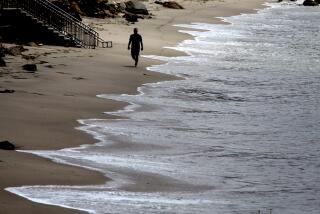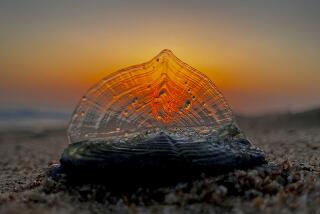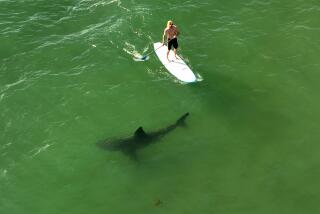FISHING / DAN STANTON : Tagging Program Helps Study the Movement of Fish
On Monday night, 40 anglers were aboard L.A. Harbor Sportfishing’s First String for the sand bass tag-and-release project.
The project is entering its third year and according to California Department of Fish and Game biologist Mac Oliphant, 1,533 bass have been tagged and 57 tags have been returned.
During Monday’s outing, sponsored by Turner’s Sporting Goods of Long Beach, 64 bass and three halibut were tagged.
Oliphant is spearheading the study of the bass, which migrate every summer to sandy beaches to spawn. Fish have been tagged in Santa Monica Bay, at horseshoe kelp and Huntington flats.
Of the 57 tags that were returned, the direction of travel showed no discernible patterns of long-distance movement.
The average distance traveled was about three miles with the greatest recovery being 22 miles.
The average days at liberty for a bass before recovery was 33 days and the longest 338 days.
The summer congregations of bass are no doubt associated with spawning patterns.
The fishery appears to be healthy based
on record numbers (400,000) of bass being caught by party boats over the past three years, field studies and lengthy observations.
Oliphant said a further study is also being done as many of the returned tags had marine growth attached to them.
However, a question remains: Are these sandies migratory or somewhat of a resident population that concentrates to spawn and then scatters, with only a few caught in the winter months?
Approval for funding to gather important information on the little-known bass fishery is expected to come from the Los Angeles County Fish and Game Commission with added support from the Los Angeles Rod & Reel Club Foundation.
Anglers are urged to send information about fish caught wearing a tag to: California Department of Fish and Game, 330 Oceangate, Long Beach, 90802.
For each tag that is returned, an angler will receive $5.
Local fishing remains good for sand bass and barracuda with some bonito starting to show. However, no concentration of the fighting boneheads have been reported.
Catalina Island anglers continue to catch 10-fish barracuda limits off the east end of Catalina. Anglers using live squid for bait are also reporting excellent catches of yellowtail and white seabass in several areas off the island.
Float-tube anglers off Palos Verdes have been catching a variety of fish from the surf line kelp beds.
King Harbor Marlin Club Member John Whittaker, fishing from his float tube, used a scampi and 25-pound test line to hook up with a white seabass. The fish weighed 25 pounds.
Felix Clark of San Pedro was dragging a feather through the surf off Point Fermin in his float tube when he hooked a bonito. As he was moving back toward shore with his catch, a wind surfer who also had a line out crossed Clark’s line and cut his fish off.
The surfer then pulled his line in and at the end of the twisted tangle was Clark’s bonito.
South Bay Catches--Ben Masters of West Los Angeles, fishing off Catalina Island aboard the Blackjack, caught the whopper of the week, a 45-pound yellowtail.
Frank Haraaguchi of West Los Angeles, fishing off Catalina aboard the Toronado, caught a 33-pound yellowtail.
Sally Schwartz of Harbor City, fishing at horseshoe kelp aboard the Hitless Miss, caught a 33 1/4-pound halibut.
Al Robbins of San Pedro, fishing aboard the Pacifica off San Clemente Island, caught a 30-pound white seabass.
Brian Fumjimoto of San Pedro, fishing off Catalina aboard the Diawa, caught a 22-pound yellowtail.
More to Read
Sign up for Essential California
The most important California stories and recommendations in your inbox every morning.
You may occasionally receive promotional content from the Los Angeles Times.










